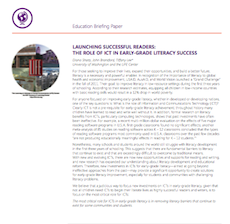
What really matters for early-grade reading? That’s a question we tackled in a recent paper for policy makers and other non-academic audiences, titled “Launching Successful Readers: The Role of ICT in Early-Grade Literacy Success.” Our aim was to help guide and frame discussions about how to have more effective investments in technology for early-grade literacy, in both developed and developing countries, based on research about what really matters for literacy growth.
No one disputes that many investments in technology for literacy have been ineffective at bringing about real and lasting change. At the same time, for many children and communities, literacy problems persist despite decades of trying to solve them with non-technology-based solutions. So, what’s the answer? Give up?
Of course not. We have to keep searching for solutions, and perhaps with new and evolving information and communication technologies (ICTs), there are new opportunities and supports for reading and writing, especially if we also look to the latest research on reading development and educational reform for guidance.
At this point I have to stop and admit that the idea for this paper wasn’t mine or my co-authors’ (John Bransford and Tiffany Lee at the University of Washington). Instead we’re indebted to Greg Butler, Senior Director of Microsoft’s Worldwide Education Leaders Strategy division. He proposed that one step toward helping policy makers make more effective investments for early literacy could be to help them become more informed about the research on early-grade reading. But there’s a catch, he noted: for wide readership of such a paper, it would ideally be five pages in length.
For researchers like us, that’s the kind of constraint that often makes us faint of heart. We do so prefer to be long-winded.
However, we took up the challenge, in part because we knew we could rely on excellent feedback from a group of expert reviewers from the field of reading research and from organizations such as USAID and the Joan Ganz Cooney Center. One of the conclusions of our paper is that part of the difficulty in bringing about real change for literacy outcomes is that there’s no simple answer to the question of what really matters for early-grade reading. Instead, the answer is multi-faceted, leading to multiple ways that investments designed for significant literacy change can fail:
If you want to have a real impact on children’s reading development, but you fail to support all the elements that matter, then the elements you failed to support could make your other efforts ineffective in the long run.
We agree completely with Kathleen Roskos and Susan Neuman when they wrote in a recent paper, “literacy education is not for the faint-hearted,” and we would only add that the sentiment may apply even more strongly to those who also take up the challenge of finding technological solutions, especially for communities facing difficulties for technology implementations of any kind.
And yet… we also believe that research suggests the promise for real solutions through technology is there. Does this mean that every piece of technology or software must address every aspect of what matters for early-grade reading? Not at all. But it does mean that policy makers must coordinate solutions across vendors (of both technology and non-technology solutions) to ensure that their strategy for improving early-grade reading is a comprehensive one. The strategy should include a set of solutions that will remove existing barriers to all the key factors for success in early-grade literacy, and it must also address general implementation challenges. Finally, policy makers need to include a plan for evaluating and adjusting the strategy once it is in place.
In the end, we did not meet the challenge of the five-page limit; our paper is eight pages long. But we hope it distills the research on early-grade reading with enough brevity for wide readership and enough details to help inform future conversations about more effective investments in technology for early-grade reading.
We’d love any feedback. What are the things we did not cover that policy makers really need to know about early-grade reading? What are other barriers to successful early-grade reading, and what are other barriers to making technology solutions feasible for different children and communities? We hope to learn more from the strong-hearted folks out there working toward solutions to these challenges.
Download “Launching Successful Readers: The Role of ICT in Early-Grade Literacy Success” (PDF)
Roskos, K. and Neuman, S. B. (2012), Formative assessment: Simply, no additives. The Reading Teacher, 65, 534–538. doi: 10.1002/TRTR.01079
 Diana Sharp, Ph.D., is the owner of Diana Sharp Consulting, providing consulting, development, and writing services for educational pioneers. She can be emailed here.
Diana Sharp, Ph.D., is the owner of Diana Sharp Consulting, providing consulting, development, and writing services for educational pioneers. She can be emailed here.


